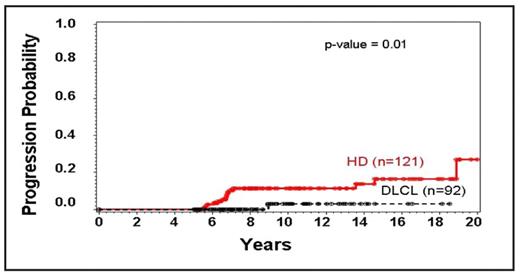Abstract
From 1984–2002, 294 patients (pts) with DLCL and 436 pts with HL (total 730) received high dose chemotherapy and ASCT at the University of Nebraska Medical Center. This analysis evaluates the long term outcome for pts in those cohorts who survived for five years and remained progression-free (PFS) during that interval with no further therapy. There were 92 pts with DLCL and 121 with HL who were alive and disease-free at 5 years post-transplant. The median age for pts with DLBL was 44 yrs (range 17–70) and 32 yrs (range 15–62) for pts with HL at the time of transplant. The median time to transplant from the time of diagnosis was 11 months (mo) for the DLCL group and 32 mos for HL pts. The majority of pts were chemo sensitive at the time of transplant – 80% for DLCL and 70% for HL. The median follow-up among survivors was 98 mo (range 61–222) for DLCL pts and 127 mo (range 63 – 272) for HL pts. The outcomes are as follows:
| Variables . | DLCL . | HL . | p-value . |
|---|---|---|---|
| PFS @ 10 yrs | 89% | 82% | 0.26 |
| OS @ 10 yrs | 91% | 90% | 0.72 |
| Secondary Malignancies | 11 (12%) | 21 (17%) | 0.26 |
| Variables . | DLCL . | HL . | p-value . |
|---|---|---|---|
| PFS @ 10 yrs | 89% | 82% | 0.26 |
| OS @ 10 yrs | 91% | 90% | 0.72 |
| Secondary Malignancies | 11 (12%) | 21 (17%) | 0.26 |
Cox regression analysis showed only age (> 60 yrs) at the time of transplant was associated with an increased relative risk (RR) of death; 7.64 (2.61–22.35) compared to pts < 40 yrs. Pts with DLCL had a RR of progression 0.12 (0.02–0.89) as compared to those with HL. Causes of death are as follows:
| Secondary malignancy | 14 (41%) |
| Disease progression | 7 (20%) |
| Organ dysfunction | 8 (24%) |
| Infection | 2 (6%) |
| Unknown | 3 (9%) |
| Secondary malignancy | 14 (41%) |
| Disease progression | 7 (20%) |
| Organ dysfunction | 8 (24%) |
| Infection | 2 (6%) |
| Unknown | 3 (9%) |
Conclusions: Patients with DLCL and HL who are progression-free at five years post-transplant have a low risk of relapse of their lymphoma. However, secondary malignancies and organ dysfunction are a long term risk from ASCT and survivors should be carefully followed for these complications.
Disclosures: No relevant conflicts of interest to declare.
Author notes
Corresponding author


